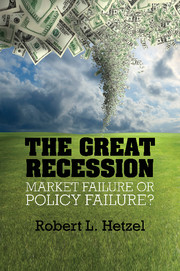Book contents
- Frontmatter
- Contents
- Figures
- Tables
- Preface
- One The 2008–2009 Recession
- Two Recessions
- Three The Great Contraction
- Four Monetary Policy and Bank Runs in the Great Depression
- Five Vigorous Recovery and Relapse
- Six Interwar International Monetary Experiments
- Seven Identifying the Shocks that Cause Recessions
- Eight From Stop-Go to the Great Moderation
- Nine Controlling Bank Risk Taking
- Ten The Housing Crash
- Eleven Bubble Trouble
- Twelve What Caused the Great Recession of 2008–2009?
- Thirteen What Caused the Great Leverage Collapse?
- Fourteen The Distinctions Between Credit, Monetary, and Liquidity Policy
- Fifteen Fed Market Interventions
- Sixteen Evaluating Policy
- Seventeen The Business Cycle
- Eighteen Why Is Learning So Hard?
- Nineteen How Should Society Regulate Capitalism?
- Postscript
- Bibliography
- Index
Four - Monetary Policy and Bank Runs in the Great Depression
Published online by Cambridge University Press: 05 May 2012
- Frontmatter
- Contents
- Figures
- Tables
- Preface
- One The 2008–2009 Recession
- Two Recessions
- Three The Great Contraction
- Four Monetary Policy and Bank Runs in the Great Depression
- Five Vigorous Recovery and Relapse
- Six Interwar International Monetary Experiments
- Seven Identifying the Shocks that Cause Recessions
- Eight From Stop-Go to the Great Moderation
- Nine Controlling Bank Risk Taking
- Ten The Housing Crash
- Eleven Bubble Trouble
- Twelve What Caused the Great Recession of 2008–2009?
- Thirteen What Caused the Great Leverage Collapse?
- Fourteen The Distinctions Between Credit, Monetary, and Liquidity Policy
- Fifteen Fed Market Interventions
- Sixteen Evaluating Policy
- Seventeen The Business Cycle
- Eighteen Why Is Learning So Hard?
- Nineteen How Should Society Regulate Capitalism?
- Postscript
- Bibliography
- Index
Summary
The Great Depression launched macroeconomics as a major discipline within economics. Nevertheless, after more than seventy years, economists continue to argue over the shocks that caused it. The issue is one of “identification.” The identification scheme used throughout this book is quantity-theoretic in spirit. For a monetary regime to be sustainable and to avoid imparting shocks to the economy, the central bank must follow a rule that provides a nominal anchor and that allows market forces to determine real variables like real GDP and employment.
The two most important monetary experiments of the twentieth century were the real-bills experiment of the Great Depression and the full-employment experiment of the stop-go era. Both began with considerable expectational stability over the behavior of prices. In both episodes, the Fed failed to provide a nominal anchor, in the first case through pursuit of the control of presumed speculative behavior on Wall Street and by banks and in the second case through pursuit of the control of the unemployment rate. Neither monetary regime was sustainable. This chapter first summarizes monetary policy in the Great Contraction (August 1929 to March 1933). It then concludes with a review of the literature on bank runs in the Great Depression and the findings of this literature with regard to the issue of whether banks regulated only by market discipline are inherently unstable.
- Type
- Chapter
- Information
- The Great RecessionMarket Failure or Policy Failure?, pp. 46 - 64Publisher: Cambridge University PressPrint publication year: 2012



